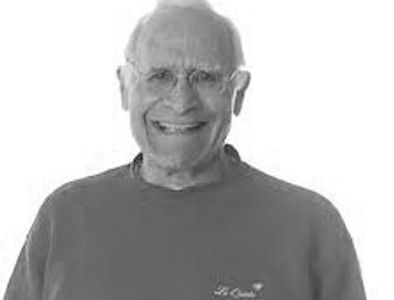Signed in as:
filler@godaddy.com
Signed in as:
filler@godaddy.com

Goldstein begins his sculpting process by mounting an armature, a skeleton of the sculpture to a wooden base, and then applying softened clay. Once he has a full-scale clay model, he casts the piece in bronze using the extensive lost wax process at a foundry. Marty finishes the process by creating c...











(American, b. 1933)
At the age of 62, Marty Goldstein retired from the corporate world and began taking numerous sculpting classes near his Southern California home. Due to his extraordinary talent and enthusiasm, he soon mastered this arduous medium and began a series of whimsical bronze "Harvey Dogs." What started as a hobby turned into a successful career in art. Over the next two decades, Marty created an inspiring collection of over 130 limited edition bronze sculptures. As a child he was passionate about animals, and dogs in particular, thus they always remained his favorite subject matter. The pieces, with their exaggerated bodies and postures, are crafted to evoke smiles, bringing joy to collectors around the world.
Goldstein’s main goal is to make others smile, so it is fitting that his sculptures became a part of a national movement to integrate the power of the arts with the healing process. In order to enhance patient care and help speed recovery, several medical institutions across the country are creating collections using Marty's artworks. The charming sculptures transform usual hospital settings into restorative and calming environments, bringing joy and hope to patients, visitors and staff.
In the Renown Children’s Hospital in Reno, Nevada, ten of his dogs are on display in the children’s emergency room. "The bronze dogs help ease the stress of the young patients" according to Phyllis Freyer, Vice President of Renown Hospital. A large installation can also be found in Santa Barbara’s Cottage Hospital.
Goldstein's sculptures range from works of pure fancy to realistic replicas that capture the spirit of his subject. His dog sculptures are now a part of several national collections including The Franklin D. Roosevelt Library in New York, which hosts a replica of FDR’s dog, Fala.
Goldstein begins his sculpting process by mounting an armature, a skeleton of the sculpture to a wooden base, and then applying softened clay. Once he has a full-scale clay model, he casts the piece in bronze using the extensive lost wax process at a foundry. Marty finishes the process by creating custom patinas for each piece. He can spend several months sculpting a single dog. Goldstein says that during the molding process, the first laugh is the litmus test to know he’s on the right track.
Marty Goldstein spent his childhood in San Diego, CA with one brother and two Irish Setters. A love affair began at that time with the two real puppies and all kinds of stuffed animals. This is really where our story begins.
Many years later, after retirement from the rigors of corporate life, he rediscovered his passion for art and was persuaded by his wife, Barbara, to take sculpting classes at the local art center. After a number of classes stressing the human form, he realized that there were many artists turning out wonderful works of art; most of the human form. Marty decided to create something different and that is when the idea of whimsical dogs and other animals came into being.
The beginning of a series of whimsical "Harvey Dogs" was begun in 1995 and has blossomed into a collection of 130 limited edition bronzes. While in the process of sculpting these pups, only those that make Marty smile will be eventually be cast in bronze using the lost wax process. He reasons that if, while sculpting, he smiles during this creative process, it is possible that others will likewise enjoy these animals and maybe even start each day with a smile or chuckle.
He knows that kids love them. Renown Hospital in Reno has a number of "Harvey Dogs" on permanent display in their new pediatric cancer ward. Cottage Hospital in Santa Barbara will be installing a large piece in their park-like setting of their new hospital.
The FDR library and museum have a replica of President Roosevelt's loving dog Fala.
"Harvey Dogs" have found homes throughout the United States, Canada, in Europe and Asia. "Dogs are here to stay," says Marty. "I am here to create the real and the whimsy in dogs for the pleasure of anyone who enjoys "Man's Best Friend."
MARTY GOLDSTEIN STATEMENT
Whimsical dogs remind me that life sometimes gets too serious and that we need a release. Funny looking dogs do that for me.
We use cookies to analyze website traffic and optimize your website experience. By accepting our use of cookies, your data will be aggregated with all other user data.